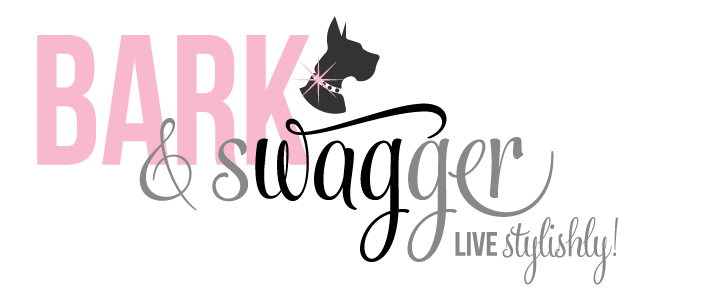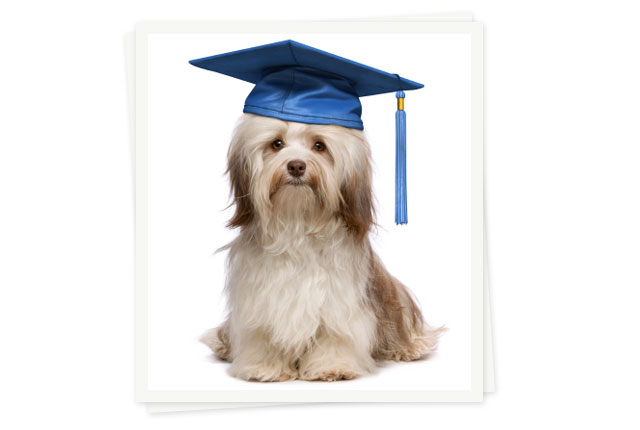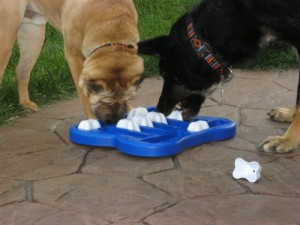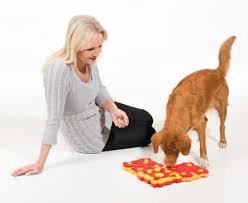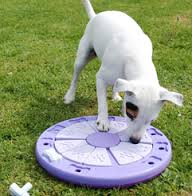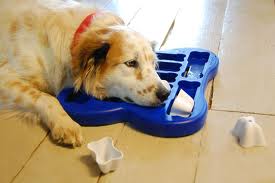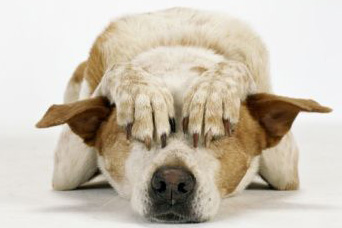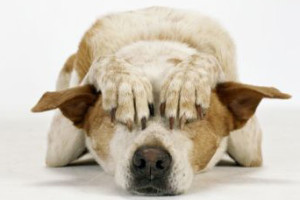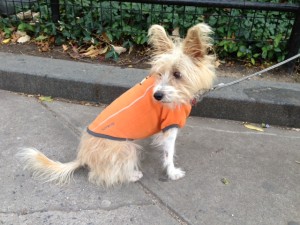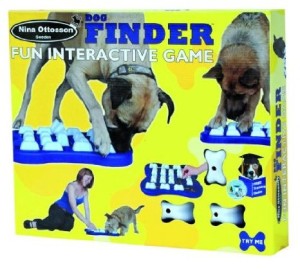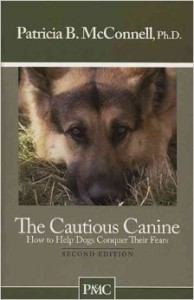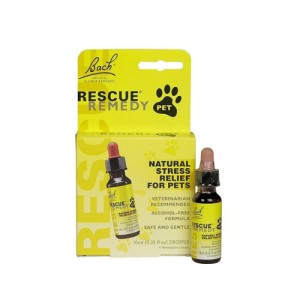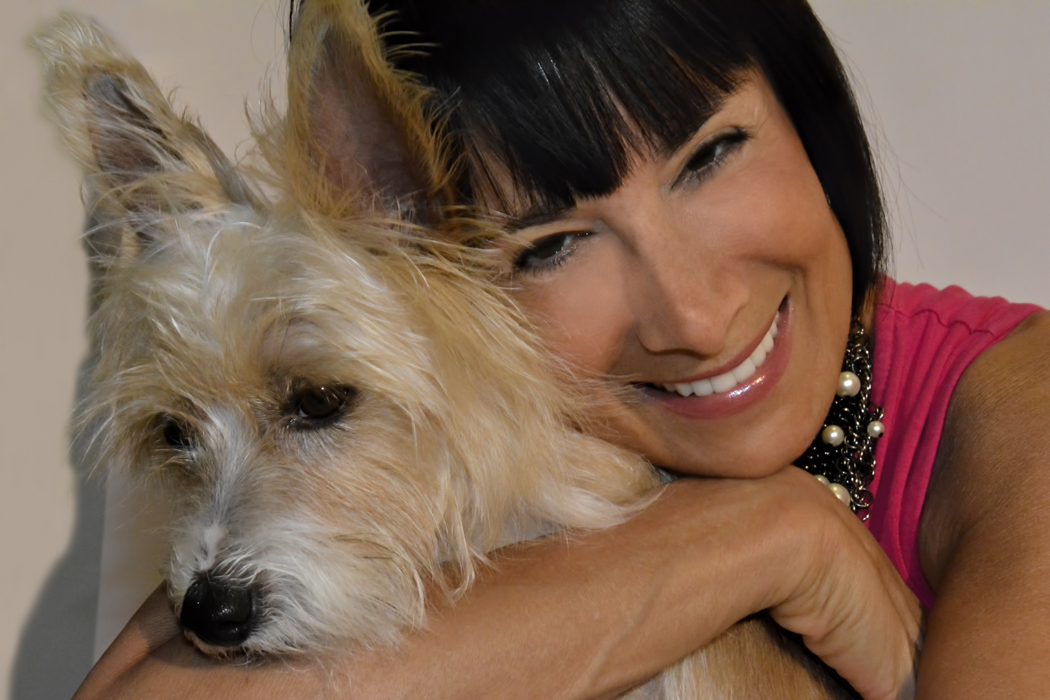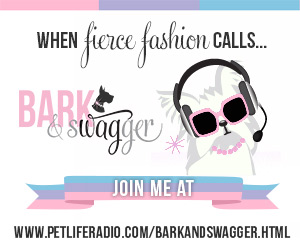Brainteasers for dogs…what’s that? Is it like Spot’s Sudoku? Is it a doggy crossword? Well, sort of. Nina Ottosson is the first lady of intelligent dog toys; games and puzzles that challenge your pup’s brain. She has this philosophy: a dog has four legs and one brain. All five need exercise. I can tell you, when Sophie is bored, look out. There’s mischief lurking! So, I think there’s a lot to be said for stimulating a dog’s brain, as well as it’s body.
Nina’s interactive dog games and puzzles are all treat-based, so if you have a food-motivated dog, you’re in luck! They range in difficulty to appeal to a wide range. And, they aren’t just for dogs. Believe it or not, Ottosson’s games can be played with cats, ferrets, parrots, even monkeys and lizards (check out the ferret playing one!). So, whether you have a Forrest Gump or an Einstein, there’s one that’s right for you.
I visited Nina’s booth at Global Pet Expo recently, and got the scoop on what’s new. She was kind enough to offer us games to try with Sophie, so I’m going to include our experience here. We were already familiar with a couple of Ottosson’s earlier toys; we had the DogFinder, a big favorite of Sophie’s and the DogTwister, which she didn’t really get, bless her. Nina sent us the new, updated DogTwister, the DogCasino and three levels of MixMax Puzzles.
I also interviewed Nina, because I wanted to know more about how her games address everyday challenges we face with our dogs, how to properly play the games, and how our dog’s personalities indicate which games they’ll excel in or how good they are at games, period.
All of Nina’s games and puzzles are rated in ascending order of difficulty from Level 1 – 4, with 1 recommended for beginners, puppies, older dogs and those difficult to motivate; Level 2 for most dogs; Level 3 for dogs that need extra mental stimulation and are the “smart” dogs and Level 4 for very advanced, highly energetic and smart pups. If you’re interested in getting Nina’s games or puzzles for your dog, hopefully this will help you in determining which ones might be right for you.
Let the games begin!
The DogFinder – Sophie absolutely loves this toy! We’ve had it for a while now, and play it regularly. Every time I take it out of the box, she goes wild. The premise is there are plastic dog bone cups that fit upside down into tracks on the board. Treats are placed under some or all of the cups, and the dog has to figure out how to lift them out of the tracks to access the treats. The challenge is that some of the bones can’t be lifted out until another of the bones is lifted first. Sophie now understands that if she paws furiously at the blocks, they will come out and she’ll get the treat. Is there any finesse involved? No. Does she get the job done? Absolutely! This is rated a Level 2 game.
The DogTwister – There’s an older, wooden version of this game and a new, updated plastic version. Sophie liked the updated, plastic version. The game is a disc with triangular blocks set into it, under which you can hide treats. Sophie had to move one block after another in a circle, in either direction, to access the treats underneath. The blocks can be locked in position by a bone-shaped peg on the upside of the game, to make it more challenging. She is just learning how to move the blocks around, so we haven’t tried it with the pegs yet. This game is rated Level 3.
The DogCasino – This is a fun toy that is rapidly becoming a favorite of hers. There are trays around the perimeter the board, with little “handles” on them. Treats are hidden in the trays, and when Sophie pulls them out with her paws, she can access the goodies. The challenge is you can place plastic bone pegs into the board near each tray, that will lock that tray in place. This was a very challenging toy for her. Nina recommended we start by learning how to open the trays, which Sophie did. She hasn’t figured out that the bone pegs release the trays or how to get them out. Sophie is still having tons of fun just opening all the trays to find her treats. This is rated Level 3.
The MixMax Puzzles (Levels 1-4) – These are new to Nina’s stable of toys, and the cool thing about them is they can be played individually, or attached to one another to create a big activity board. We started with the Level 1 puzzle, called the MixMax Puzzle A. These puzzles are about learning how to move the little inverted cups around the board and get them out to access the treats. As the levels increase, the pathways to remove the cups become more challenging to access, requiring Sophie to manipulate movable pieces on the board as well as the little cups. We received levels A – C in difficulty, with C being the equivalent of a Level 3 game, but we haven’t progressed past A, yet. Oh, dear… 🙂
Here’s one of Nina’s videos showing how to play the DogWorker game:
After experiencing the games with Sophie, I had points of reference to ask about how the dogs learn.
The Interview
BaS: What were the first toys you created and why?
N.O.: The Treat Ball, also called Qulan, the DogSmart and the DogSpinny in wood were the first, because they address the basics and are games the dogs can easily handle. Moving the ball to find treats, knocking out pegs or spinning the disc, they could do that. In 1989 and ’90, I had given birth to my children, so my two dogs weren’t getting as much exercise. I felt guilty about it! That was my motivation to create the toys.
BaS: How can the games solve everyday behavior issues we have with our dogs?
N.O.: The games help owners connect with their dogs in a meaningful way. I’ve found that using them can help with destructive behaviors. Boredom is the key to problem dogs. If owners allowed the dog to use its brain for a minimum of 15 minutes each day, in addition to physical exercise, of course, we should’t have as many problem dogs as we have today.The games help with focus, discipline because you can tell the dog to wait for your cue before beginning to play and were designed to tap into their natural hunting instincts.
BaS: With senior dogs, it’s probably good to keep the brain active, too, right?
N.O.: Absolutely, yes! My two senior dogs have stayed very sharp and active playing the games. It’s been great for them. Also, when my dog was injured, I put the game on a chair and was able to keep her stimulated when she couldn’t go out and run.
BaS: What about puppies, who have short attention spans. How long a period do you recommend playing a game?
N.O.: For a puppy, I’d recommend starting at about ten weeks old, and only playing for ten to fifteen minutes per session. But, it also depends on the dog. If it’s a border collie, they can probably do it a little longer. For most puppies, taking breaks is important, because they can’t concentrate for very long, like kids. So, after ten or fifteen minutes, take one and then you can do another session.
BaS: You mention Border Collies can go a bit longer. We’re been told they are a very intelligent breed. What other breeds have you found to be able to handle more challenging games?
N.O.: Australian shepherd dogs, other herding dogs and the Nova Scotia Duck Tolling Retriever. They have a lot of energy and are very smart. If they aren’t mentally exercised, they will find other things to do you might not like!
BaS: Who are your product testers?
N.O.: I actually have a 2-year-old Nova Scotia Duck Tolling Retriever named Thea, who is a great tester. I also have two Bouvier des Flandres, a breed I love and have been breeding for over 30 years now. My two, Nessa and Velle, have been brought up playing the games. I also have a small family dog, Elsa, a Poodle/Papillon mix, who does some testing, too.
BaS: On the average, how much time does it take a dog to learn a toy?
N.O.: It depends on what level you start on. If you start on a lower level, it may take ten minutes for the dog to learn how to play. But, if you start on a difficult level, it could take a long time. I compare it to crossword puzzles. If it’s a very difficult one, we can’t do it. If it’s manageable, we can do it and try one more difficult next time. It’s the same for a dog.
BaS: I noticed you have a collaboration with Dognition, the company that determines what personality type your dog has through exercises you do with them. Sophie did the Dognition exercises. I actually did a story on it for Bark and Swagger. Her personality type is a Renaissance Dog, meaning she’s good at a little bit of everything. How do you determine what games make the most sense, depending on what personality type the dog has?
N.O.: Sometimes it’s very easy, depending on the dog. For example, The Expert, they want to solve problems by themselves. They go for the games, they try to find the treats. You don’t need to help them too much. And they often solve very difficult games because they are very motivated to do whatever it takes. With The Charmer,they are very social dogs. They often want to have a little help from you. Maybe they don’t have the skill and the energy to solve the problems themselves, so maybe you start with an easier game first. I’ve done these kinds of tests since the early 90’s, and because of what I found, I began to develop different products and different levels for different types of dogs. It’s so interesting to see how, even in the same breed, dogs respond differently to the games.
BaS: I noticed that Sophie can’t manage to pull out the bone pegs in the DogCasino game. I’m not sure if it’s an intelligence thing or if it’s because she’s small and can’t manage to get a hold of them. What do you recommend?
N.O.: Try tying a string around the bones and let her pull them out that way, and put treats under the bones, too. That’s important to further motivate her. Is your dog a paw dog, as opposed to the mouth?
BaS: Yes, she is. She definitely focuses on using her paws to play the games.
N.O.: That’s part of it. Some dogs are paw dogs, some are mouth. Some are left focused, some are right. It’s funny.
BaS: How many toys in all have you created over the 20+ years you’ve been doing this?
N.O.: About 45. Right now, I think we have 35 different games in stock.
BaS: What are your most popular?
N.O.: The DogTornado, the DogBrick, the Dog Treat Maze and the DogPyramid are the most popular. They are mid-range in difficulty, so they suit most dogs.
BaS: I saw that you’ve done contests with a row of dogs, each playing a particular game, kind of like a brainiacs challenge. Do you do a lot of these and why?
N.O.: Yes, I do this at various shows. It’s a great way to show people how the dogs really love playing the games. Some people think their dogs aren’t smart enough to play. With the contests, they see that they can.
Nina Ottosson’s toys are manufactured adhering to strict quality guidelines. All wood blocks in the wooden games are made of hard and dense wood from Swedish beech trees. In all of the plastic toys, they’ve used non-toxic and recyclable plastic.
Where to buy: Amazon
Price range: $8.50 – 59.95
Do you have a lovable Forrest Gump or whiz-kid Einstein? What do you think of these games? I love hearing your stories! Tell me in the Comments below.
(Disclaimer: I am an affiliate of Amazon. Please visit our Disclaimer & Disclosure Policy for more info.)
